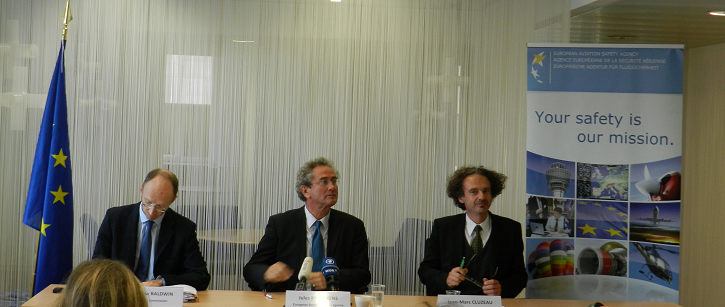


credit: ECA, EASA Press Conference, Brussels, 1 Oct 2012
Unlike plane crashes, Flight Time Limitations (FTL) for air crew rarely make any headlines.
This is why the joint press conference of the European Aviation Safety Agency (EASA) and the European Commission on 1 October was rather a formality to present the final EASA proposal for EU-wide FTL rules. Journalists were keen to know the “facts” regarding the new maximum flight duty time, duty hour limits, maximum early starts or standby time.
Yet, there was one big question hovering in the room: what are the odds of a tragic incident or accident happening due to pilot fatigue? Because this is what the “harmonization” of rules across Europe – in the form now proposed by EASA – would eventually entail.
With the new proposal, safety standards are being leveled down in several EU countries, commercial interests put ahead of safety, and flexibility ahead of scientific evidence. EASA knowingly disregarded unanimous scientific evidence, including the 3 reports it itself commissioned in 2011 and failed to embrace the precautionary principle.
Crucially, EASA’s proposal allows flight schedules that are outright dangerous, for example allowing a pilot to land an airplane – full of passengers – at the end of a 22 hour work day. Under these new rules, pilots and cabin crew will be flying while dangerously fatigued, landing aircraft after excessively long flight duties, often after multiple take-offs and landings, and insufficient rest periods.
“What are the chances that [an accident] will happen? One in 20,000,000?,” thought Scott Maurer, father of Lorin Maurer, passenger 3A, who lost her life when Continental (Colgan) Flight 3407 crashed in 2009. “Sadly”, he says, “I now know that fatigued pilots increase those odds exponentially.”
Authorities and politicians often need a fatal wake-up call before they are ready to introduce strict safety rules. In the USA, it wasn’t until after the deadly Colgan Air plane crash that the issue of pilot fatigue came under scrutiny and new safety rules were adopted.
This is why in a letter to Siim Kallas, Vice-President of the European Commission and Commissioner responsible for transport, Scott Maurer is calling on the EU to review the EASA proposal very carefully.
If not, what are the odds that European passengers will escape an accident with the pilots nodding off in the cockpit?
Note: Surveys among European airline pilots show that 50-54% of them say their already fell asleep in the cockpit without agreeing this with their colleague and 71-90% say they make errors due to being fatigued.